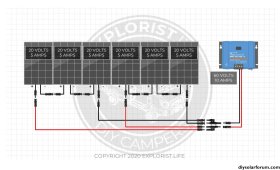2s2p or 3s2p.
Orient strings differently so the don't all make max current at the same time.
10 awg 90 degree C wire actually has ampacity 40A; it is only the code police who say 30A.
Code says Isc x 1.56, but that's related to nuisance tripping of thermal breakers.
Magnetic-hydraulic breakers don't need the second 1.25x for nuisance trip. That leaves just 1.25x for cloud edge effects (not 1.56x).
Anything beyond that is code writers, not physics or engineering.
Or buy a higher voltage charge controller, as suggested, and let that charge the battery feeding your inverter.



